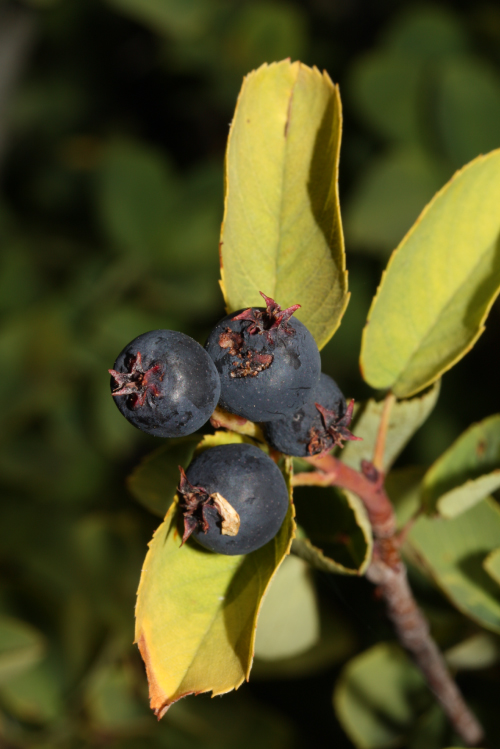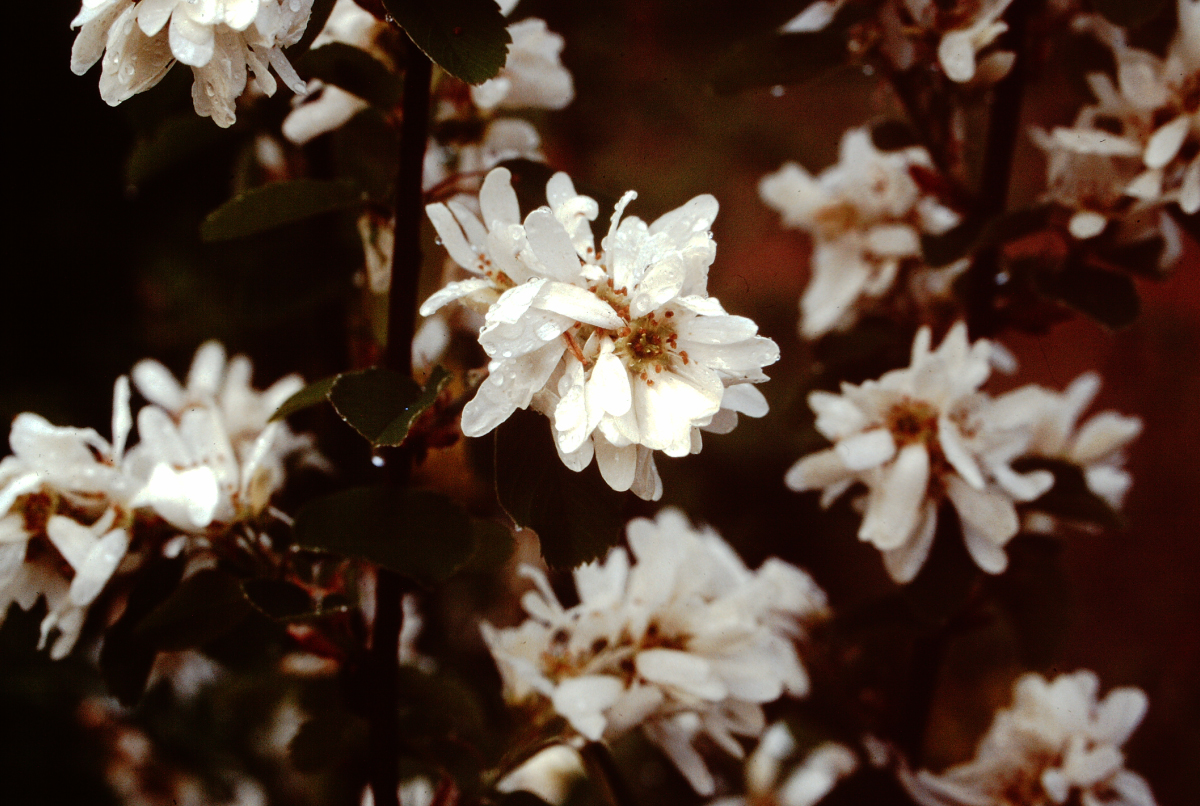Amelanchier alnifolia

Saskatoon Berries. By Walter Siegmund (talk) – Own work, CC BY-SA 3.0, Link
Northern North America is not known as a source of important of fruit crops. Most of our familiar fruits such as apples, plums, and cherries originated elsewhere. Several of our native species, such as coastal strawberry (Fragaria chiloensis) have been used in breeding programs. However, Saskatoon (also Saskatoon serviceberry), a showy shrub of the Rose Family (Rosaceae), provides wild fruit and is now grown as a commercial crop.
Saskatoon grows as a medium shrub to small many-stemmed tree reaching to 7 m (23’) high. The smooth stems are reddish brown to dark grey, and young twigs often silky. The 2.5 – 3.0 cm (1-1.2″) long leaves have an oval outline, but may be slightly pointed at the tip and heart-shaped at the base. Small teeth line part, or all the leaf’s margin. Young leaves are bright green but turn bluish green with age.
Bright white flowers occur in leafy clusters toward the ends of the branches. Somewhat hairy sepals form a base for the 1-2 cm (0.4-0.8”) long strap-shaped petals. About 20 stamens choke the throat of each flower, where they surround four to five styles.
The ovary of Saskatoon, like that of the apple or pear, is placed in an inferior position. This means that the sepals and the petals arise from the top of the ovary rather than below it, as is the case in a superior ovary.
The fruit is about 0.5 to 1.0 cm (0.2-0.4”) across, and globe shaped. Its colour ranges from purple to nearly black, often covered by a greyish blue bloom. Good quality fruit is juicy and sweet, however on the coast some of the berries dry out quickly becoming mealy or crunchy with little flavour.
Saskatoons thrive throughout British Columbia. The continental range extends along the coast from Alaska to California, eastward to New Mexico and north through the plains and prairies into Canada’s Northwest Territories. This shrub favours open to lightly shaded sites such as thickets, fence rows, clearings and edges of woods. A well-drained soil is essential.

Mid spring flowers of Saskatoon. Photo by Dr. Richard Hebda.
Saskatoons were and are widely picked by First Nations. The Nlaka’pamux (formerly the Thompson) people recognized several types of bushes. Some types were gathered and dried for winter use. Other types were cooked to a jam-like form before being dried. Edible roots of other plants were sometimes soaked in Saskatoon juice to make them more flavourful and sweeter. Dried and rehydrated berries were added to dried vegetables and cooked into soups and puddings.
Many parts of the Saskatoon plant were used. A drink was made from the bark for stomach problems. Bark and twigs were turned into a medicine for recovery after childbirth and, in combination with other plants, to make a contraceptive. The tough hard wood made excellent arrows. Other uses included digging sticks, spear shafts and handles for tools. Saskatoon sticks were used to spread out cleaned salmon for drying, and the branches to construct shelters.
Today many British Columbians eat fresh berries off the bush or bake them in tasty pies. You can buy Saskatoon bushes specially bred for the home garden. These varieties produce bigger and sweeter fruit than most wild plants. In the prairies Saskatoon plantations yield the raw material for a regional specialty, Saskatoon wine.
Growing Saskatoons is an easy matter if you have a sunny well-drained site. In the late winter or early spring, buy a bush from the garden centre or order it through the mail. Plant the sapling in a moderately rich, but not heavily-fertilized, soil and mulch around the base. You may have to water during the first year to help the young plant settle in. Saskatoon shrubs can be used in many parts of the garden; the spring flowers are stunning and the bright yellow to red fall leaves provide a cheerful accent. Plants can be grown from seed and dug up as self-sown seedlings too.
The origin of the name Amelanchier remains unclear. The species name “alnifolia” means alder-leaved.
Saskatoon is an outstanding native shrub widely adapted to B.C.’s varying climates. Not only does it yield tasty fruit, but it serves well as a showy garden subject. To see Saskatoon berries visit the Native Plant Garden of the Royal British Columbia Museum, Victoria, B.C.


